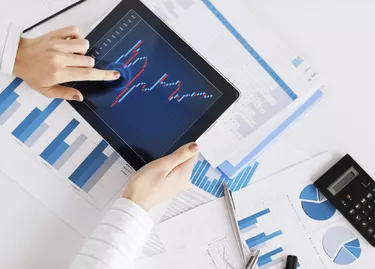
In economics, the terms "short run" and "long run" compare the effects of time on business performance or conditions. The short run assumes that a small time period introduces restrictions that don't exist in the long run. Short run calculations and observations may be used independently or compared directly with similar long run scenarios in order to add a frame of reference to conditions and predictions.
Short Run: Economics Definition
Video of the Day
If you want to define short run in economics, it helps to compare it with long run in order to illustrate the concepts of both because it can be challenging to consider one without considering the other. According to the Corporate Finance Institute, a short run is a period of time not long enough to allow change to certain economic conditions. In contrast, the long run is defined as a period of time that is long enough to encompass all economic conditions and variables.
Video of the Day
Variables and Short-Run Analysis
When studying interactions between products and consumers over a short run, a company's investment in a factory, for example, is fixed and constant over the period being examined. As demand rises and falls, however, material and labor investment changes with demand. These expenses typically increase with demand and it is important to factor those costs into financial planning.
If demand increases sufficiently, there isn't time in the short run to build new factories to accommodate additional production. This can cause stock shortages or delays in delivering goods to customers. When demand falls in the short run, the company can cut back staffing, hours and material purchases, but its facilities remain constant. This means that the company must still pay for things like utilities, taxes and insurance associated with the building.
Comparing the Long Run
Using the example above with a long run time scale, a company would look at a period of time in which factories and production facilities are also a variable. According to Investopedia, if demand rose sufficiently, there is sufficient time to add another plant to meet demand. With loss of demand, a plant could be shut down or sold.
Short run and long run have no standard time frame attached, since different businesses have different requirements. For instance, a gift wrapping service could open and close locations in shopping malls quite quickly, while a do-it-yourself warehouse business must locate land and build before opening. Because of this, short run and long run periods must be set for each individual business and industry.
Using the Short Run Outlook
The short run is used primarily to analyze production for a single facility or department. A typical income statement covers a short run view. Revenues are compared against the total sum of costs of goods sold, such as labor and materials, and fixed costs, such as building costs, administration, utilities and any other expense that must be paid regardless of sales volume.
A manager controlling costs in the short run may have some savings available from fixed costs, but most of his decisions will also involve adjusting costs of goods sold.
Consider Also: How to Calculate a Supply Run in Economics, and How to Calculate Total Revenue in Economics